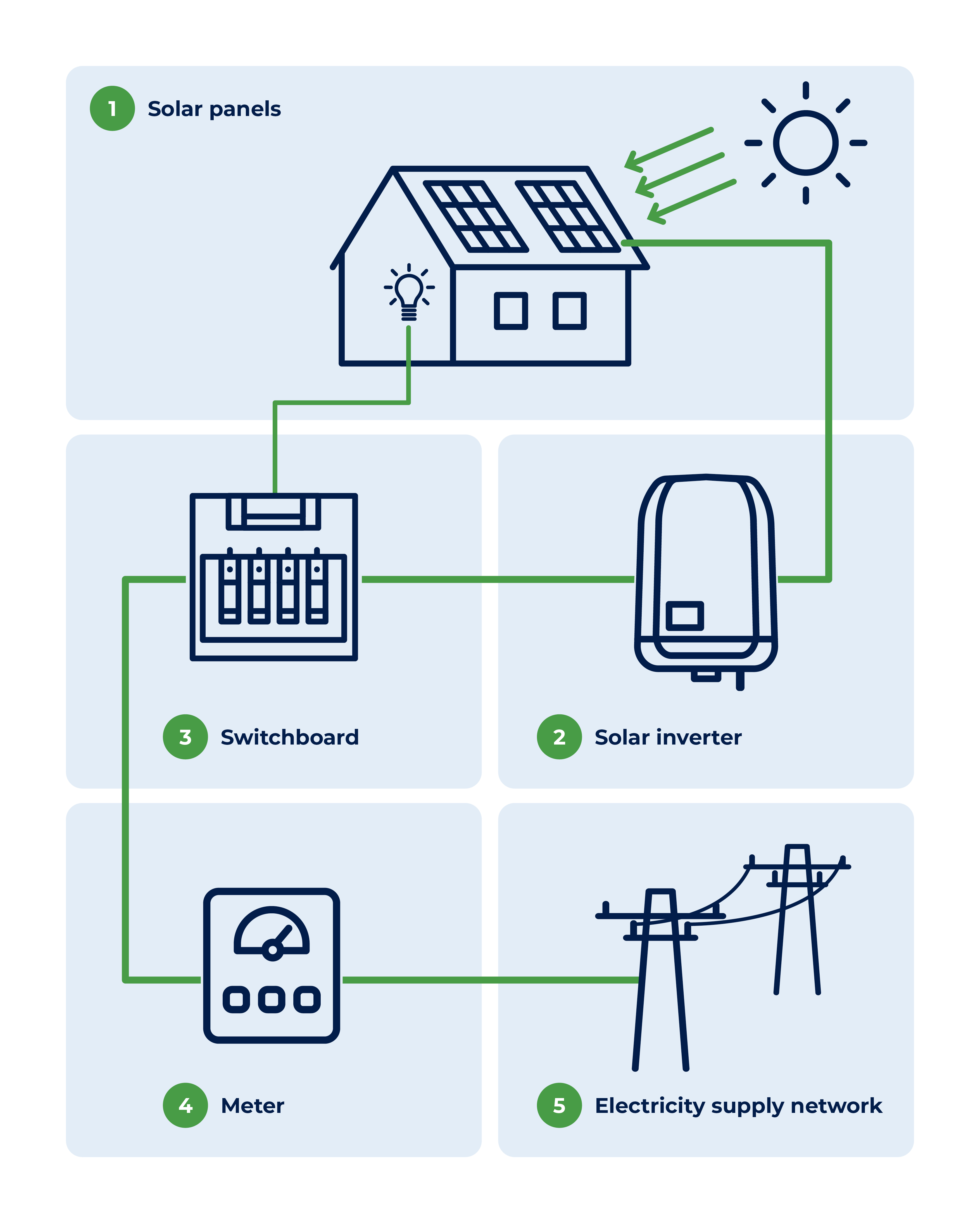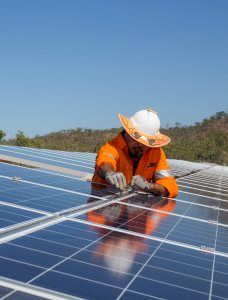The Northern Territory is seeing a renewable energy revolution with more energy sources connecting into our network than ever before – particularly from residential solar photovoltaic (PV) systems.
It’s an exciting time as we strive to reach the Northern Territory’s aim of being 50 per cent powered by renewables by 2030.
This rapid growth also brings some challenges. Like all operators around Australia, our electricity supply system was built long before solar energy was an option. The influx of so many new power sources makes it harder to manage and balance supply and demand.
It can be complicated so this section explains what happens to solar power that’s generated by rooftop systems, what it means for our network and the electricity system, how you can get the best return on your solar investment and what our energy future looks like.
How rooftop solar generation works
If your home is fitted with solar PV panels, it will also have an inverter component, which converts solar energy into electricity. That electricity is used to supply your home first and, if you have one, your home battery system.
When your solar system is producing more energy than your home is using, the surplus gets fed back into our network.
This is when you can receive a renewable energy buyback - or 'feed-in tariff' - from your electricity retailer and be paid for the energy that your system is exporting into the network.

1. Solar panels
Convert sunlight to electrical energy
2. Solar inverter
Converts direct current (DC) electricity, generated from the solar panels, to alternating current (AC) electricity, which can be fed into the electricity supply network
A residential solar system may also include a ‘behind the meter battery energy storage system (BESS)'
3. Switchboard (electricity to house)
Your home uses electricity firstly from the solar PV with any additional needs supplied from the electricity network
4. Meter
Measures the electricity you produce and how much you use
5. Electricity supply network
Any excess can be exported back into the electricity supply network
Or a battery stores excess energy from solar panel that you don’t use during the day.
Why solar generation can be tricky to manage
Power networks were originally designed to deliver electricity to homes in a one-way system. Now, rooftop solar panels are feeding power back into the network as well.
This can be a good thing, because it reduces our reliance on traditional energy generation.
However, when overall household, or community demand for energy is low, and the sun is still shining and solar systems are at peak production, we can get a situation where a lot of solar systems will try to export excess energy back into the grid at the same time.
That’s when our network can become congested. As more and more solar systems compete to export, they elevate the voltage in the community.
These elevated voltages can then cause everyone's solar systems around you to trip off. When this happens all of the energy they were providing must instantaneously be replaced by traditional generation.
The best way to prevent the system from becoming unstable is to use the electricity locally as it is created.
Another challenge is intermittency and managing the system when clouds come over and the sun disappears. On these occasions, back-up is needed that can respond quickly to these changes and ensure electricity is available. This back up is from traditional power generators, which must be running at all times to ensure there is no loss of power supply.
Alternatively, where practicable it may be from a battery energy storage system.
How you can get the best return from your solar system
Getting the most out of your system is about using as much of your own solar energy as you can while it’s being made – during the day.
By using your own energy, you are avoiding having to buy it from your retailer. There’s a probability the cost of the energy you buy from your retailer may be much higher than any solar feed-in tariff you might receive.
Here are some ways to get the best return from your solar power while you’re making it.
Cooling or heating your house during the day
If you’re home during the day, using your air conditioner or heater will use your power as you make it.
Run your hot water system throughout the afternoon
An electric hot water system provides another opportunity to maximise your solar energy. Set your hot water system to heat up during the day and make the most of the peak solar production time.
Looking after your pool
If you have a swimming pool, run your pool pump during the day when the panels are receiving sunlight. If your pool is temperature controlled, set your timer for it to run during the day.
Set timers for your laundry and kitchen
Fill up your dishwasher or washing machine and set a timer so they turn on during the day.
You’ll effectively be doing your chores without even needing to be in the house!
Consider what other energy intensive appliances you can set to a timer during the day.
Cook dinner
By running a slow cooker, you can use your solar power during the day and come home to a ready-to-eat dinner.
Change charging behaviours
Recharge your appliances like tablets and laptops during the day, so you can switch them off at night.
Garden on solar
Your solar energy can be used to power many items in the garden too. Powering electric tools such as lawnmowers and trimmers can be an excellent way to make the most of your daytime solar.
Don’t have a solar PV system of your own?
There are several utility-scale solar farms in the process of connecting to our Darwin grid. By choosing to run your appliances during the day where you can, you will be playing your part in helping improve your electricity and carbon consumption profile and assisting these solar farms to operate at their full potential. This is an important contribution that has the potential to encourage more renewable energy developers to invest in our region.
What the energy future looks like
At Power and Water, we are working hard on a range of initiatives to adapt to the rapid growth of renewables.
It’s something power system operators around Australia are grappling with, and it’s going to take time, innovation and investment. We are committed to embracing this exciting future.
Home batteries are becoming more affordable and offer customers the ability to better manage their electricity consumption.
If you're a Northern Territory homeowner, business or a not-for-profit organisation, you can apply for a grant through the Northern Territory Government's Home and Business Battery Scheme to buy and install batteries and inverters.
The Northern Territory Government has set a high target for the use of renewables for electricity supplied to households and businesses throughout the Territory through its Roadmap to Renewables.
Our aim is to enable the Northern Territory's goal of 50 per cent power consumption to be provided by renewable energy by 2030.




